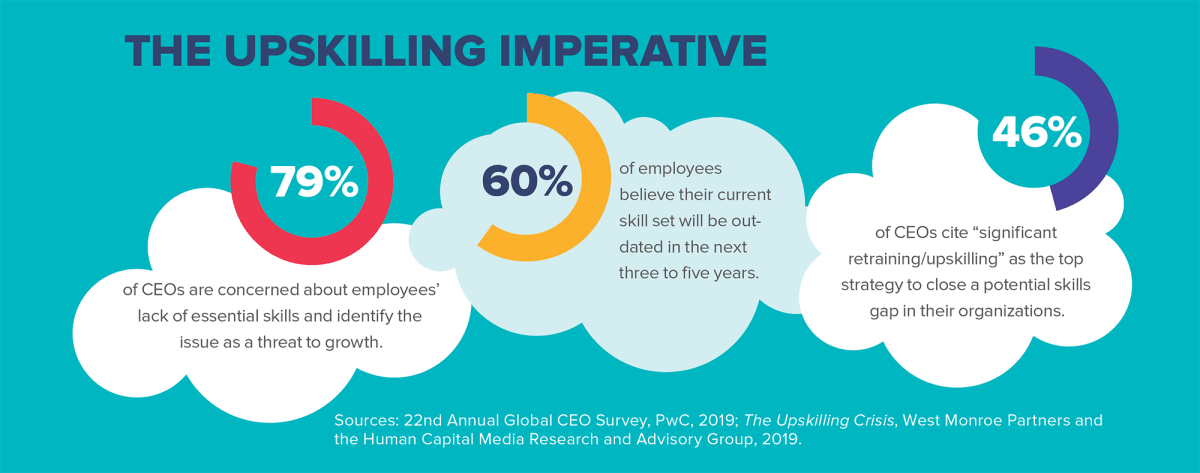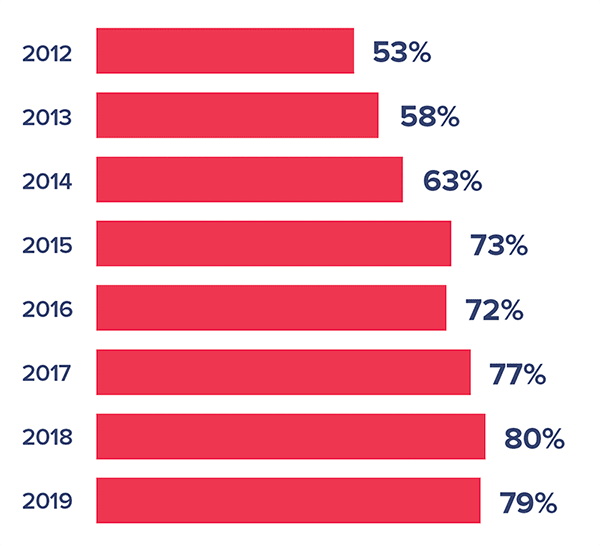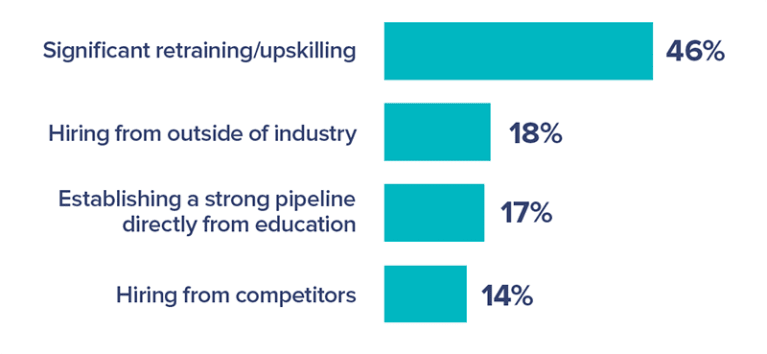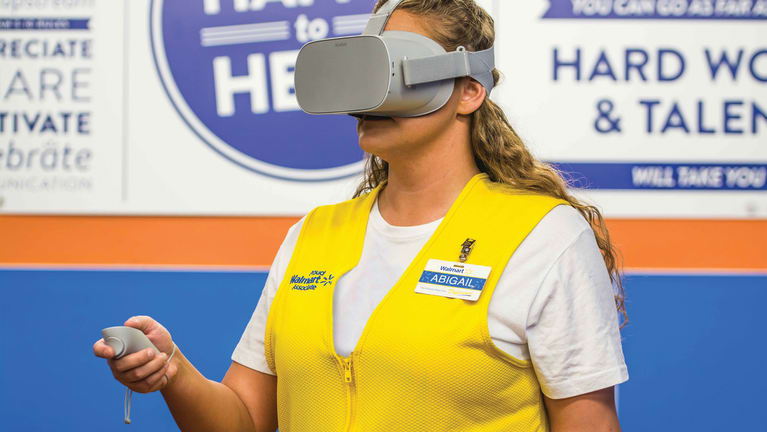Upskilling Benefits Companies and Employees
Training current employees helps companies meet evolving business needs and gives workers skills required to rise to new heights.
As employers such as hospitals, pharmacies, grocery stores and manufacturers grapple with increased demand due to the coronavirus, they’re teaching current employees new skills to meet fresh needs.
At bedding company MyPillow Inc., located outside Minneapolis, factory workers learned how to sew surgical masks for health care workers instead of bed linens.
“We had to retool the cutting machines and reset the computers,” says CEO and founder Mike Lindell. “We did it all in about three days. If we see something is better, we adjust immediately to maximize space and production.
“All of the employees were excited to help,” says Lindell, who converted 75 percent of the company’s manufacturing capacity to mask-making.
While MyPillow retooled, the pandemic forced other companies to reduce operations or shutter altogether. The state of Ohio encouraged those employers to help workers improve their skills during the downtime by offering a $2,000 reimbursement for every technology-focused credential earned by an employee, up to $30,000 per company. Many of those credentials could be earned online.

“Help upskill your employees during this time so, when we rebound, we will be ready,” said Ohio Lieutenant Governor Jon Husted at a press conference earlier this year. “When we come out of this [pandemic], the digital economy will be even more powerful than it is now. This is a time to upskill yourself.”
By 2022, 54 percent of all employees will require significant upskilling, according to the World Economic Forum. Many companies have already made a commitment to train current employees to help them develop skills to meet the changing demands of their jobs. In the process, workers often acquire advanced digital skills that qualify them to be promoted to positions in high demand.
Digital Upskilling
About three years ago, John Heinen worked in IT at global professional tax and consulting company PricewaterhouseCoopers (PwC). “I realized I needed to do something to improve my career,” he says. “I decided to get my master’s degree in data science.” Then he heard about PwC’s Digital Accelerator program. “So I raised my hand to join.”
The immersive Digital Accelerator training program for employees focuses on specialties such as automation, artificial intelligence (AI), data and digital storytelling. Heinen attended a kickoff event in October 2018 and was all in. “It was supposed to be a 10-week endeavor,” he says. “I finished it in two weeks.”
By April 2019, Heinen had landed a senior manager position within the company’s enterprise digital transformation and analytics group. “I used the knowledge I’d learned to save the firm a good amount of money,” he says. “I pivoted my career seamlessly to what I wanted to do in finance and data analytics.”
He had extra motivation, too. “I’m a little older, and it was important to me to show my son I could finish something I started. It’s never too late to learn new things and do what you need to do to be successful.”
PwC is in the process of upskilling all 50,000 of its U.S. employees. It has three levels of training: Digital Hub for all employees; Digital Academy for roughly 15 percent of employees annually; and the Digital Accelerator program for 5 percent of employees, including Heinen. More than 23,000 employees have completed the Digital Academy program, and more than 1,000 have participated in the Digital Accelerator program, which is set to expand this year.
“When people hear ‘upskilling,’ they think they must learn how to create bots, but that’s just a piece of it,” says Carrie Duarte, workforce leader of the future for PwC. “Upskilling is being able to work socially in a digital world. Technology allows people to post things and communicate ideas so they can innovate quicker. It’s about making a CRM [customer relationship management software] system accessible to everyone. This is not your grandmother’s upskilling.”
The Gaps
Upskilling can address skills gaps as varied as leadership ability and data analysis.
“We expect most Fortune 500 companies will have an upskilling program within 12 to 18 months,” Duarte says. “Just about everyone is looking for employees adept in robotic process automation, materials science or simulations with machine learning that can predict outcomes and streamline processes. They also need people who can master softer skills, such as managing teams effectively.”
Research demonstrates the need for training: 56 percent of HR professionals surveyed said their organizations’ skills gaps are moderate to severe, according to The Upskilling Crisis, a 2019 study by West Monroe Partners and the Human Capital Media Research and Advisory Group. Additionally, 63 percent said their organizations have not equipped managers with upskilling resources.
A common gap materializes when data-entry jobs become automated and employees who once spent time entering the data now have time to analyze it. “But that’s inherently a different skill set,” explains Michael Hughes, managing director of operations excellence for West Monroe and a co-author of the study. So employers that install new CRM software need to train workers to use the tool but also “to think differently and make different decisions,” he says.
To identify skills gaps, AT&T uses an internal website similar to LinkedIn. Employees showcase their certifications, and supervisors scan for people with the skills they seek. “It allows us to inventory our talent supply and compare it to our skills demand to determine the gaps we need to close with targeted training programs,” says Jason Oliver, vice president of AT&T University Operations in Dallas.
GROWING CONCERN ABOUT SKILLS
The percentage of CEOs who say they’re extremely or somewhat concerned about the availability of people with key skills as a threat to their business has grown in recent years.

Source: 22nd Annual Global CEO Survey, PwC, 2019.
Becoming an Employer of Choice
Upskilling opportunities like those provided by PwC and AT&T can set an employer apart in the search for talent. “Employers who offer valuable training opportunities build their reputations as employers of choice,” says Kelly Aiken, vice president for the National Fund for Workforce Solutions, a nonprofit organization in Washington, D.C.
“Generation X and Millennial employees rank ‘lack of career progress’ among their top reasons for leaving a job,” Aiken adds. “Upskilling reduces turnover.”
That’s especially helpful when talent is hard to find.
AT&T employs about 250,000 workers and spends roughly $200 million annually on employee training. “We actively recruit candidates with tech skills, but the supply is limited and competition is fierce,” Oliver says.
“There aren’t enough prospective recruits, and the expense [of hiring new workers] would be enormous,” Duarte adds. “Companies must upskill their existing employees.”
Ryan Carson, CEO of Treehouse Island Inc., a Portland, Ore.-based online coding school that trains people to become entry-level software engineers, calls it a talent war. “There are too many jobs and not enough qualified college graduates,” he says. “It’s better business to upskill people who already work for you and give them a career path. If there’s no path, they’ll leave.” Upskilling reduces risk, he adds, because the company is not hiring unknown candidates.
Inclusion is another potential benefit of upskilling, says Ali Levitan, head of strategic business development and innovation at General Assembly, a training company headquartered in New York City. “I love seeing more women and underrepresented groups move from nontechnical roles into software engineering roles.”
Upskilling can provide a path forward for these groups. “The front line might be diverse, but management might not be diverse at all,” says Jaime S. Fall, director of Upskill America at the Aspen Institute, a nonprofit education and policies organization headquartered in Washington, D.C. “Some companies try to ensure more people have access to those opportunities [through training].”
CEOs FOCUS ON UPSKILLING
Top strategies to close potential organizational skills gaps.

Source: 22nd Annual Global CEO Survey, PwC, 2019.
Program Models
Upskilling programs take several different forms, but most adhere to one of the following five models:
Internal training. Walmart opted for in-house upskilling. The Walmart Academy was created in February 2016 to provide needed training to 8,000 new managers. Then the retail giant turned its attention to the workforce as a whole—2.2 million employees—and the Walmart Academy evolved. Today, the company has 201 academies inside Walmart Supercenters and modular classrooms in store parking lots where employees, called “associates,” receive training. On average, each academy has five classrooms and serves associates from 25 stores. The company says its upskilling effort resulted in the promotion of 215,000 employees in 2018.
“We view a store as an extension of the classroom,” explains Ayreann Luedders, senior director of the Walmart Academy. “The majority of our training is experiential on the sales floor.”

By the end of 2019, the Walmart Academy had trained 245,000 associates in the classroom and 1.1 million associates using virtual reality (VR) technology. The company has 17,000 Oculus GO VR headsets—four in every Supercenter. “When VR was incorporated, retention increased 10 percent,” Luedders says. She also credits VR with less time spent in training: “We didn’t realize it’d have such a huge impact.”
Similarly, PwC’s upskilling relies heavily on virtual simulations. “We have digital quest games every Tuesday and Friday at 2 o’clock where a couple of thousand people play,” Duarte explains. “You can get some small monetary awards, and, if you participate as a team, you can get a multiplier award.” The quests lead employees through real-life client scenarios.
Duarte says one of the keys to PwC’s upskilling program is asking employees to nominate themselves for participation. “Those are the people who will be the most excited. Historically, we have a top-down way of identifying high-potential talent. But by getting people to self-identify, you find the people who are the most curious.”
PwC also created an internal training tool and marketplace called Digital Labs. When employees develop a bot or streamlined process, they post it in Digital Labs, where it becomes available to the entire workforce. Each time another employee downloads it, the creator receives a small monetary award. “Employees have earned tens of thousands [of dollars] by having their bots used,” Duarte says. “People are excited and committed.”
This increases employee efficiency and gives workers an incentive to share their ideas. Heinen has created nine different products for Digital Labs, and they have been downloaded a total of 3,600 times. “It’s motivating to see thousands of people use your work,” he says.
Apprenticeships. The American Hotel and Lodging Association Education Foundation sponsors a formally registered lodging management apprenticeship program. “Eighty percent of participants are front-line or midlevel associates selected for an upskilling program to advance them into management careers,” says Shelly Weir, senior vice president of career development for the foundation in Washington, D.C.
The apprenticeship program has a 94 percent retention rate among the 1,000 lodging and restaurant industry employees who are enrolled or who have completed the program, and the apprentices see an 18 percent wage increase, on average, as they upskill.
“Our industry is open 24 hours a day, seven days a week, 365 days a year, so 90 percent of our apprentices take classes online,” Weir says. “The rest take classes at a local community college.”
Partnerships with vendors. Guardian Life Insurance Company of America, a mutual insurance company headquartered in New York City, partners with training company General Assembly to train its workers. The program has provided more than 1,000 employees a variety of upskilling opportunities, including a data science for data professionals program, says Diana Scott, employee value proposition and chief human resources officer.
“We have large teams of actuaries that quantify and analyze risk,” Scott says. “Technology has helped make that work more efficient, but we need data-science skills. We have an enormous amount of data and not enough people with the skills to operationalize it. Because our actuaries are highly analytical people with skill sets complementary to data analytics, we saw an opportunity to offer development programs to fill that gap.”
The company selected participants based on their math-intensive roles, and in nine months they learned Python fundamentals, machine learning, AI, and data extraction and wrangling. Learners also completed capstone projects, such as new ways to analyze customer claims.
The hotel and lodging foundation also partners with an outside company—Pearson, an educational organization that manages the day-to-day logistics of the organization’s debt-free college program. AT&T partners with several online learning organizations, including Udacity.
Partnerships with universities and community colleges. AT&T has partnered with both online and brick-and-mortar institutions. “With Georgia Tech and Udacity, we helped create the first-ever online Master of Science in computer science degree in 2014,” Oliver says. “We worked with Udacity to offer nanodegree credentials to our employees.” The self-paced, fast-track technical credentials are in areas such as data analytics, he adds.
Partnering with a university or a community college is different from offering traditional tuition reimbursement—a practice that some experts encourage employers to reconsider. “When you have an employee working a minimum-wage job, it’s unrealistic for her to [pay upfront for] a semester of tuition and wait months to be reimbursed,” the Aspen Institute’s Fall says. Instead, he recommends that companies consider tuition disbursement, with employers paying education providers directly. For example, hamburger chain Five Guys recently launched a debt-free college program for employees. The company pays 100 percent of tuition upfront for classes toward a degree in finance, business administration or hospitality management and up to $5,250 per year toward other degrees such as supply chain management.
These partnerships place a strong emphasis on career counseling. “Programs use success coaches to help people think wisely about job opportunities available at the end of the program to motivate them and help them make better choices,” Fall says.
Five Guys provides its employees with a personal education coach for the duration of the program.
Multiple career training programs. Over the next six years, online retailer Amazon plans to train 100,000 employees—about one-third of its workforce—through a $700 million investment.
“Upskilling is important because the American workforce is changing,” says Ardine Williams, vice president of workforce development at Amazon. “There’s a greater need for technical skills than ever before. We have multiple programs, including Career Choice, Associate2Tech and the Amazon Apprenticeship.”
In the 90-day Associate2Tech program, associates receive virtual instruction and get paid study time during their workweek to prepare for an industry-recognized entry-level PC computer service technician exam.
Career Choice may be the most unique program Amazon offers. “Career Choice trains our hourly employees for in-demand roles in the community that pay more than their current jobs,” Williams says. “People frequently ask why we’d train people for jobs outside the company. While we’d love for all employees to grow a career at Amazon, at some of our locations there aren’t a wide variety of roles available.
“Providing a skilled talent pipeline for local employers makes good business sense,” Williams adds. “Career Choice helps us attract strong talent and adds upskilling to a good wage and robust benefits.”
A Life Changer
Rosanny Valerio credits upskilling with changing her life. “I started with AT&T as a wire technician in field operations,” she says. “It was a great place to start, but I aspired to do more.” She earned a bachelor’s degree in technical management while working full time by taking advantage of AT&T’s tuition assistance program. Then she used the organization’s Career Intelligence online portal to see which skills were in demand at the company and chart a training path in data analytics.
“Employees search for jobs based on their current competencies,” Oliver explains. “They might identify 20 jobs for which they’re at least 50 percent qualified, pick those they’re most interested in and link to the training required for the jobs they’d like to pursue.”
In August 2018, Valerio began a data analyst nanodegree through Udacity. “I got promoted into data and mechanization,” she says, “and less than six months later I moved to Atlanta to be a technical business manager.” She continued to learn new skills and now works as a technology development program engineer.
“Every time I took on a new educational goal and completed it, I was overwhelmed with excitement,” Valerio says. “The skills and confidence I gained helped my career take off in ways that would never have been possible had I not continued my education. There were times I felt so unprepared, but I always found a course, tool or mentor to help me through it.”
The new digital revolution is much the same as the industrial revolution of 100 years ago. If companies are going to thrive, leaders need to prepare employees to keep pace.
“You have long-standing, valued employees whose skills no longer contribute in the same way they used to because of advances in what we can do with technology or new ways of working,” Guardian Life Insurance’s Scott says. “We’re focused on ensuring everyone sees opportunities for themselves.”
Kathryn Tyler is a freelance writer in Wixom, Mich.


